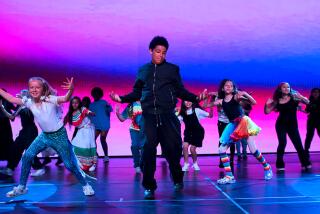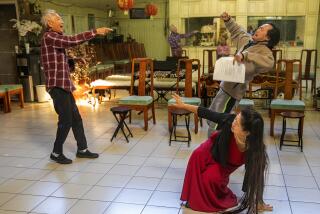DANCE REVIEW : Flamenco at Center of CSLAâs âKaleidoscopeâ
âDance Kaleidoscopeâ took a double risk Friday at Cal State Los Angeles.
Bypassing ballet, modern dance and jazz (to be featured on later programs), this annual showcase of Southern California achievement opened with an evening of world dance: work rooted in traditional cultures. And instead of presenting any of the relatively high-profile Mexican, Japanese or Korean companies of the Southland, director Donald Hewitt focused on more isolated or marginalized artists and groups.
Centerpiece of the event: three facets of the areaâs varied flamenco community, none purer than the dynamic, brooding âSolearesâ danced by Yaelisa, an elegantly proportioned woman with a superb mobility of back and a rare ability to share emotion without dramatizing or projecting it.
Feeling simply emanates from her, coloring the gorgeous line and rhythmic sophistication of her performance, bringing you close to the tragic vision at the core of this debased, indomitable Gypsy idiom. Antonio de Jerez and Bruce Patterson supplied artful accompaniment.
At the opposite extreme: âDanzas Clasicas,â by Roberto Amaralâs Ballet Espanol de Los Angeles. Here Antonia Lopez, Valeria Pico, Irene Heredia and Amaral danced to taped orchestral music, doggedly duplicating its rhythms and clattering over its sonorities.
Amaralâs opening solo boasted mesmerizing stretching motions and other disarmingly intimate gestural ideas proving he hasnât entirely lost his early brilliance. However, the final sequence relied on delirious emoting and sexual salesmanship as much as dancing, with a haughty woman in white and a slinky woman in black vying for his favors--while he seemed to need neither of them so much as the spotlight.
Midway between Yaelisaâs and Amaralâs modes of flamenco expression came Juan Talaveraâs Spanish and Flamenco Dance Theatre. Partly a florid production number for tourists, the companyâs âViva el Flamencoâ began with an alarmingly uneven corps of 18, then settled into more reliable professionalism with a cadre of eight--but grew fully persuasive only in Talaveraâs solo.
With his compellingly weathered face and volatile movement style, Talavera drew you deeply into the dramatic contrasts of his dancing--the rapid, finely calibrated traveling steps (with the upper body suspended in slow motion) or the sudden ferocity of attack in a concluding flourish. Moreover, his interaction with the accompanists (Antonio Triana, Antonio Alcazar and Patric Halgo) always yielded excitement. So why the 15 women framing him in the finale and other descents into empty spectacle?
Possibly because thatâs what Talavera thinks it takes to survive in Southern California. Aggressively working the audience for an ovation doesnât belong to flamenco tradition any more than it does to the culture of West Africa. But Talavera and Amaral have danced in Hollywood long enough to learn what sells, and Leon L. Mobley of DWADD (Djimbe West African Drummers and Dancers) also clearly knows the bottom line.
Flinging a group of dancers into the audienceâs teeth proved to be DWADDâs sole intention on Friday. No matter that the unisons always looked slovenly and the solos varied from excellent to mediocre, âDounbaâ kept up the pace and pressure relentlessly: African dance reconceived for a âTerminator 2â sensibility.
The company grew from a drumming ensemble and its musicianship remains spectacular enough to sustain even the poorest dancers--but the manipulative energy-circus cliches need drastic rethinking. The seven groups in âAfrica Oye!â and, more recently, the Ballet du Lac Tumba Bikoro of Zaire have given Americans a sense of the variety, dignity and depth of Central and West African performance traditions. Why should we accept anything less from our home-grown artists?
Chinese and South Indian classical dance differ in so many ways that it was a surprise to find Alice Lo and Ramya Harishankar emphasizing the same mercurial expressivity in their solos on Friday. In âSpring on a Moonlit River,â Lo created a wealth of patterns and images with two half-moon fans, looking perfectly effortless as she glided in and out of sculptural poses, while emotions flickered delicately across her face.
In âMallari,â Harishankar exploited the bold directional oppositions of the Bharata Natyam tradition, with a deep rhythmic pulse linking all her technical effects to the devotional final image. Taped music accompanied both Lo and Harishankar.
Recently reviewed pieces by Avaz International Dance Theatre completed the program.
âDance Kaleidoscopeâ resumes Friday with a program of ballet and modern dance.
More to Read
The biggest entertainment stories
Get our big stories about Hollywood, film, television, music, arts, culture and more right in your inbox as soon as they publish.
You may occasionally receive promotional content from the Los Angeles Times.










